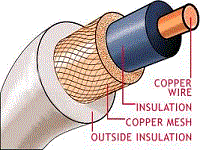Mode Theory
The
mode theory
, along with the ray theory, is used to describe the propagation of light along an optical fiber. The mode theory is used to describe the properties of light that ray theory is unable to explain. The mode theory uses electromagnetic wave behavior to describe the propagation of light along a fiber. A set of guided electromagnetic waves is called the modes of the fiber.
PLANE WAVES
The mode theory suggests that a light wave can be represented as a plane wave. A plane wave is described by its direction, amplitude, and wavelength of propagation. A plane wave is a wave whose surfaces of constant phase are infinite parallel planes normal to the direction of propagation.
The planes having the same phase are called the wavefronts. The wavelength (lambda symbol) of the plane wave is given by:

where c is the speed of light in a vacuum, f is the frequency of the light, and n is the index of refraction of the plane-wave medium.
The picture below shows the direction and wavefronts of plane-wave propagation. Plane waves, or wavefronts, propagate along the fiber similar to light rays. However, not all wavefronts incident on the fiber at angles less than or equal to the critical angle of light acceptance propagate along the fiber. Wavefronts may undergo a change in phase that prevents the successful transfer of light along the fiber.
Plane-wave propagation.
Wavefronts are required to remain in phase for light to be transmitted along the fiber. Consider the wavefront incident on the core of an optical fiber as shown in the picture below. Only those wavefronts incident on the fiber at angles less than or equal to the critical angle may propagate along the fiber. The wavefront undergoes a gradual phase change as it travels down the fiber. Phase changes also occur when the wavefront is reflected. The wavefront must remain in phase after the wavefront transverses the fiber twice and is reflected twice.
The distance transversed is shown between point A and point B on the illustration below. The reflected waves at point A and point B are in phase if the total amount of phase collected is an integer multiple of 2π radian. If propagating wavefronts are not in phase, they eventually disappear. Wavefronts disappear because of destructive interference. The wavefronts that are in phase interfere with the wavefronts that are out of phase. This interference is the reason why only a finite number of modes can propagate along the fiber.
Wavefront propagation along an optical fiber.
The plane waves repeat as they travel along the fiber axis. The direction the plane waves travel is assumed to be the z direction as shown in the picture above. The plane waves repeat at a distance equal to lambda/sin Theta. Plane waves also repeat at a periodic frequency beta = 2pi sin Theta/lambda. The quantity beta is defined as the propagation constant along the fiber axis. As the wavelength (lambda) changes, the value of the propagation constant must also change.
For a given mode, a change in wavelength can prevent the mode from propagating along the fiber. The mode is no longer bound to the fiber. The mode is said to be cut off. Modes that are bound at one wavelength may not exist at longer wavelengths. The wavelength at which a mode ceases to be bound is called the cutoff wavelength for that mode. However, an optical fiber is always able to propagate at least one mode. This mode is referred to as the fundamental mode of the fiber. The fundamental mode can never be cut off.
The wavelength that prevents the next higher mode from propagating is called the cutoff wavelength of the fiber. An optical fiber that operates above the cutoff wavelength (at a longer wavelength) is called a single mode fiber. An optical fiber that operates below the cutoff wavelength is called a multimode fiber.
In a fiber, the propagation constant of a plane wave is a function of the wave's wavelength and mode. The change in the propagation constant for different waves is called dispersion. The change in the propagation constant for different wavelengths is called chromatic dispersion. The change in propagation constant for different modes is called modal dispersion.
These dispersions cause the light pulse to spread as it goes down the fiber (see the illustration below). Some dispersion occurs in all types of fibers.
The spreading of a light pulse.
Become a loyal member to our site. It's free!
Site Search


Translate your page
If English is not your first language you can Translate the text on this page to any one of the languages found in the drop down menu. Select your language from the list for an instant translation.
Looking for something unique for your project? Choose from the drop down menu for quick access to the item you seek.
Related Pages
Become an Electronics Technician
Convert most anything with this utility
Find your wire and cable here!
Sponsored Sites


If you like this site please pay it forward. Donations are welcome.















